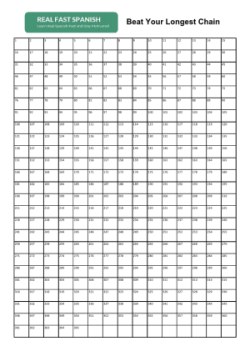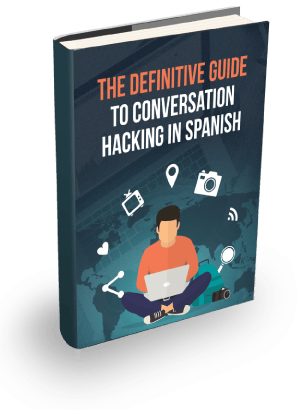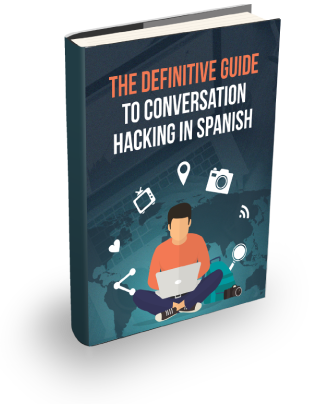There is more than one way to learn Spanish. The good news—the two approaches are not mutually exclusive. You can use one to complement the other. But before you learn about the two approaches, you need to know about the one overarching principle that applies to both.
“Time over time trumps talent every time” – Jay Papasan
As much as we love a quick fix, a ‘do this’ and it will all be easy. The most tried and true principle is to get your butt in the chair and do the work.
Regular practice will be your key to success. It sounds simple, but for most it is easier said than done.
Practice Everyday
Difficult grammar or an overwhelming number of words to learn will not slow you down, it is time without practice that will delay your goals.
This killed my progress when I was learning. I would go a month or two without practicing which was of course a month or two that I wasn’t getting better. When I was practicing everyday it was great, my vocab was improving and my grammar was getting better, but when I took time off I forgot words and it all got a bit messy.
If you want to learn and learn quickly then practice every day. It doesn’t have to be much – four hours crammed in a locked room studying is not necessary. Regular exposure is what you need most.
When I was going well I would use a combination of listening CD’s, podcasts, bedtime reading and training books. Sometimes if the only thing I did for the day was spend 5 minutes flicking through a Spanish reader (combination English-Spanish book) then that would be enough to get some exposure to the words.
Lets face it, maintaining an everyday routine is tough. A busy life with multiple commitments will pull you in different directions but this is where the ‘why’ comes in. Remember what’s motivating you to learn, this should help when you are distracted, tired and looking for other things to do.
Once you have established a practice everyday habit you can then consider which approach you want to take based on your goals.
Approach One: Language Hacking
Language hacking is an approach that you can read a lot about. It’s where you look for the biggest gains for minimum effort.
Tim Ferriss talks about it in each of his books but covers it in the most detail in his latest book The 4-Hour Chef.
The approach is essentially about understanding the Pareto Principle and applying it to learning.
Pareto was a famous Italian economist who observed that 80% of the wealth is accumulated by 20% of the people, 80% of the land is owned by 20% of the people, in hospitals 20% of patients require 80% of the resources and in business 80% of profits come from 20% of the customers.
Once understood, Pareto’s principle can be applied to language learning.
In Spanish there are around a total of 100,000 words. But many of these words are seldom used.
A study of Spanish word frequency demonstrated that the top 1000 words are used for 87.8% of spoken language, with 76% used in non-fiction and 79.6% in fiction writing.
This is the Pareto Principle exaggerated, only 1% of the total Spanish vocabulary could give you almost 90% of what you need for spoken Spanish.
Now before you get too excited you still have to practice listening and grammar. But it is not beyond the imagination to learn around 30 words a day for 30 days and have 90% of the vocab ticked off.
This is the essence of language hacking and I will write more about this in future posts but for now understand that it is an approach that can be used depending on your goals.
Approach Two: Mastery
The other approach to language learning is that of mastery. Mastery is not about getting maximum reward for minimum effort. It’s about moving towards perfection and fluency over time.
Mastery is about long term practice with the aim of constant improvement. If you plan to live in a Spanish speaking country then I suggest this is the approach you should take.
To help give some light on how to approach the topic of mastery I want to refer to a principle that Jerry Seinfeld called “Don’t Break The Chain”
Jerry Seinfeld is arguably one of the best comedians on the planet. It may come as a surprise that his technique for developing his skill was as simple as practicing everyday.
He would take out a calendar and mark a red cross on the days he would write a joke. The aim is to get long red unbroken chains of red crosses. He made game out of it, he would constantly challenge himself to get the chain as long as he could and beat previous records.
If you are considering the path of mastery in Spanish, try this yourself. I have provided a 365 day calendar that you can print off to start putting up the crosses. Download it here.
Put it in a place you can see regularly. Start marking crosses on the calendar when you practice. If you break your chain, start again and see if you can beat the previous streak.
Which ever approach you take, remember the principle of time over time and regular practice. Whether you are going the hacking route for minimum effort and maximum results or the mastery approach you are going to have to sit down, fight the resistance and do the work.
Celebrate the small wins and mini milestones and after a month straight of daily practice and an unbeaten streak you may surprise yourself with how much your Spanish has improved.





Great article 🙂 I’m somewhere in the middle here for sure. I think i’m at an intermediate level of Spanish where I could maintain this and do fine for most of my travels. But I want to advance to a higher level anyway.
p.s.
Cool last name 😉
Hey Jon, glad you liked the article. Mastery of Spanish is a long journey but well worth the effort! Keep up the good work.
And, it’s always nice to meet another Barr 🙂
Hi, thanks a lot for you post. I have a question. For example
where can I find the most used 1,000 words to begin with?
Hola, you can access the 1,000 words by signing up for the free guide ‘The Definite Guide to Conversation Hacking in Spanish’ at the bottom of this page or on the side of the page.
Hola, what’s a good book to exercise a beginner?
Hola James, there are lots of books out there, each with pros and cons. I own about 30 Spanish books in a combination of grammar text books, dictionaries, short stories, and learning techniques. I suggest you do some research at your local library to work out which style of book you are after. If you can find a book at the library…great! If you find something close but not quite right then head over to Amazon to see if you can find a better fit there. I hope that helps!